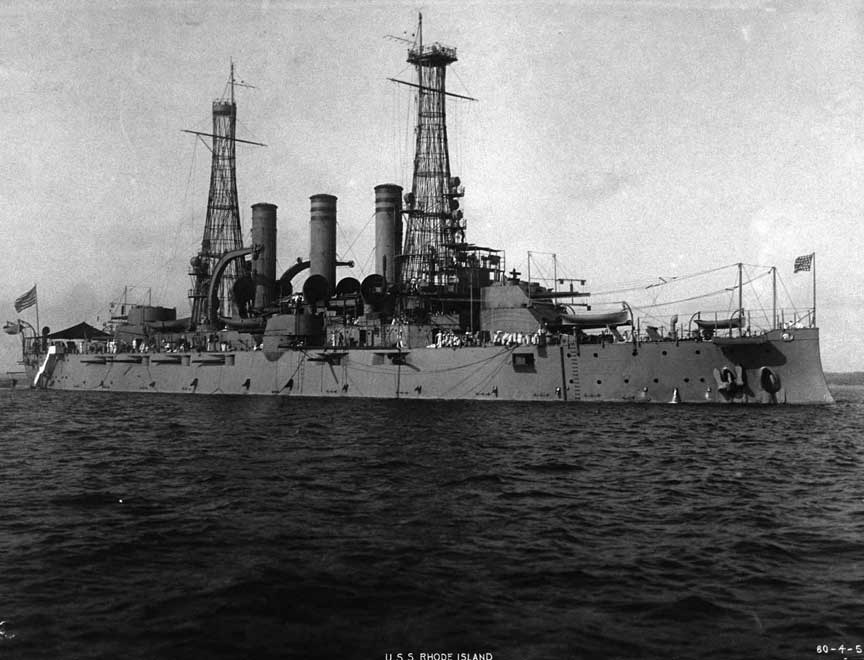USS Rhode Island BB-17

(Rhode Island II
(BB-17: dp. 14,948 (n.),1. 441'8" b. 76'3", dr. 23'9", s. 19 k.; cpl. 812; a. 4 12", 8 8", 12 6", 12 3", 12 3-pdr., 4 21" tt.; cl. Virginia)
The second Rhode Island was launched 17 May 1904 by Fore River Shipbuilding Co., Quincy, Mass.; sponsored by Mrs. F. C. Dumaine; and commissioned 19 February 1906 Capt. Perry Garst in command.
Rhode Island underwent extensive shakedown and acceptance trials on the U.S. east coast between Hampton Roads and Boston before being assigned to Division 2, Squadron 1, Atlantic Fleet 1 January 1907. The battleship departed Hampton Roads 9 March 1907 for Guantanamo Bay, Cuba, to participate in gunnery practice and squadron operations evolutions.
She then returned north to cruise between Hampton Roads and Cape Cod Bay.
Arriving in Hampton Roads 8 December 1907, Rhode Island joined 15 other battleships, a torpedo boat squadron, and transports, for the great fleet review which began the cruise of the Atlantic Fleet to the west coast and around the w orld. President Theodore Roosevelt reviewed the "Great White Fleet" 16 December and sent it on the first leg of the long voyage. Rhode Island called at Trinidad, British West Indies Rio de Janeiro, Punta Arenas, Callao, and Magdalena Bay before arriving at San Diego, Calif., 14 April 1908.
The fleet remained on the west coast into July, Rhode Island steaming north to visit the Puget Sound area during June. The entire fleet departed San Francisco 7 July 1908 for Honolulu, Auckland, Sydney, Melbourne, and Manila, arriving in the Philippines 2 October. From Manila Rhode Island made for Yokohama, Japan, returning to Olongapo, Philippine Islands, at the end of October. Departing Cavite 1 December Rhode Island visited Colombo, Suez, Marseille, and Gibraltar before returning to Hampton Roads 22 February 1909
Subsequently entering New York Navy Yard for overhaul, Rhode Island was reassigned 8 March 1909 to Division 3 Squadron 1. She continued to serve with the Atlantic Fleet into 1910 participating in exercises including deployment southward to the Caribbean during February 1910. Assigned 20 October 1910 to Division 4, Squadron 1, Rhode Island and other fleet units were reviewed 2 November at Boston by President Taft prior to their departure for European waters. In an elaborate battle and scouting problem, the fleet continued its training, Rhode Island subsequently visiting Gravesend, England, before returning to Guantanamo Bay 13 January 1911.
Rhode Island continued her duties attached to the Atlantic Fleet up to the outbreak of war in Europe in 1914. She cruised southward to Key West, Havana, and Guantanamo Bay during June aml July 1912 but otherwise remained on the east coast operating between Hampton Roads and Rockland Maine. Reassigned to Division 3, Squadron 1, Atlantic Fleet Rhode Island became division flagship 17 July 1912. She transferred the division flag to New Jersey l August in the periodic rotation of additional flag duties among units of her division.
The Commander, Division 3, Squadron 1 transferred his flag from Virginia to Rhode Island 28 June l9i3 and remained on board until 18 January 1914. At the end of 1913, Rhode Island cruised off the Mexican coast to protect citizens and property threatened by deteriorating political developments ashore. Arriving off Vera Cruz 4 November 1913, Rhode Island operated off Tampico and Tuxpan into February 1914. After 2 weeks at Guantanamo Bay the battleship returned northward to Virginia waters.
Rhode Island kept up her continuous schedule of annual docking ancl overhaul gunnery practice, and squadron maneuvers well into l916. She remained off the U.S. eastern seaboard but oeeasionally steamed into more southerly waters
she called at Caribbean ports during October 1914 to March 1915 and January to February 1916. Rhode Island undertook additional duty as flagship, Division 4, Squadron 1, from 19 December 1914 until 20 January 1915.
Placed in reduced commission in reserve 15 May 1916 at Boston Navy Yard, Rhode Island was detached from the Atlantic Fleet the following day. The battleship flew the flag of the Commander-in-Chief, Reserve Force, Atlantic Fleet from 24 June 1916 to 28 September.
Returned to full commission 27 March 1917 at Hampton Roads, Rhode Island broke the flag of the Commander, Battleship Division .3, Atlantic Fleet, 3 May 1917 shortly after the United States entered World War I. Undertaking vigorous gunnery practice and emergency drills to reach combat readiness, Rhode Island was assigned antisubmarine patrol duty off Tangier Island, Md. Based at Hampton Roads into 1918 Rhode Island was transferred to Battleship Division 2 during April. Remaining ready for overseas deployment, Rhode Island undertook special torpedo proving trials during June 1918.
Upon the war's end in November 1918, Rhode Island was ordered to assist returning U.S. troops from France. Fitted with hundreds of extra bunks, the hattleship made five roundtrip voyages across the Atlantic between 18 December 1918 and 4 July 1919. In all she transported over 5,000 men from Brest, France, to Hampton Roads and Boston.
Designated flagship of Battleship Squadron 1, Pacific Fleet 17 July 1919 at Boston, Rhode Island departed Boston Navy Yard 24 July for Balboa, C.Z., and Mare Island Navy Yard to undertake her new assignment. After remaining at Mare Island into 1920, Rhode Island decommissioned 30 June and was placed in reserve.
Rendered incapable of any further warlike service 4 October 1923 in accordance with the Washington Treaty limiting naval armaments, Rhode Island was sold 1 November 1923 for Scrapping.
 >
>